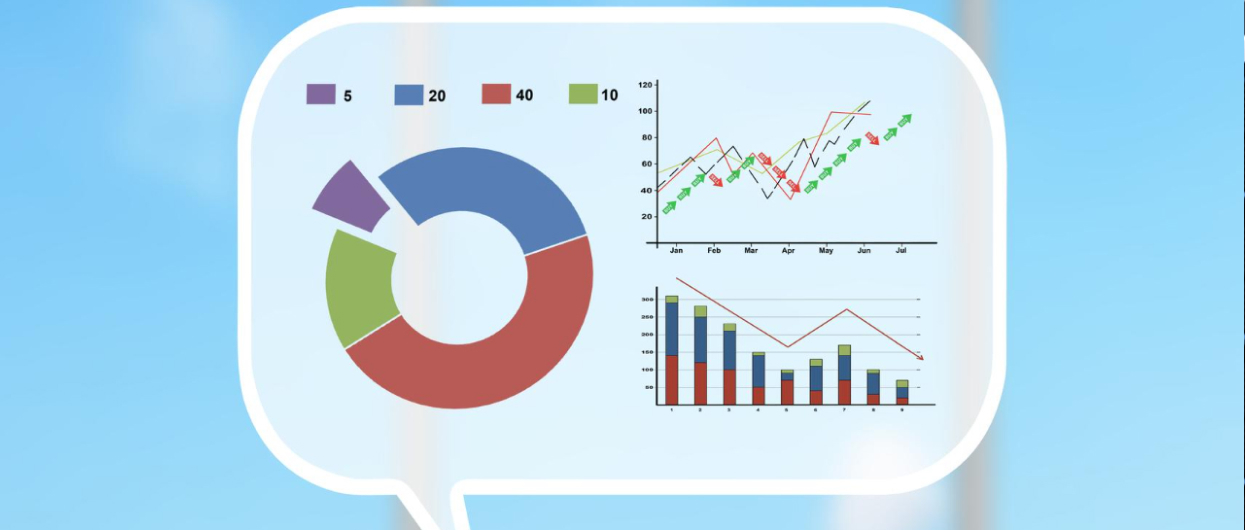
With the proliferation of technology and the digital transformation of businesses, companies now enjoy access to a wealth of raw, self-produced data from various sources. This abundance of data presents a unique opportunity for organizations.
How can you gain insight from data if it cannot be understood? It is essential to distinguish valuable data from useless, and data analysis helps make this possible.
What is Data Analytics?
Data analytics involves using various techniques and algorithms to extract, process, and analyze raw data to draw meaningful conclusions. By leveraging automated processes, data analysts can quickly and efficiently analyze large datasets to provide insights into patterns, trends, and correlations.
Data analytics can extract valuable insights from any data, enhancing operational efficiency. Analyzing data, trends, and metrics that would otherwise go unnoticed can be uncovered, helping to improve processes for better overall performance.
What is Business Intelligence (BI)?
Business intelligence is the ability to access, analyze and interpret information to make enlightened decisions and maximize the capacity of corporate operations.
BI includes methods and strategies that enable companies to transform raw data into valuable knowledge. Examples of BI technologies include data mining, online analytical processing, data warehouses, and reporting. Using BI, businesses can identify trends, patterns, and correlations within their data to make more informed decisions.
Also read: 10 Business-Critical Digital Marketing Trends For 2021What’s The Difference Between Business Intelligence and Data Analytics?
Business intelligence (BI) is a compilation of software tools meant to allow organizations to utilize their data to track and improve performance. It concentrates mainly on analytics, reporting and interactive dashboards.
On the other hand, data analytics focuses on information analysis to gain insights and identify trends to address business issues. It generally requires a deeper dive into the data than BI does.
Data analytics can validate hypotheses, assist in forecasting and explore different approaches to a specific problem. While BI requires only basic data manipulation, data analytics is often more complex and involved.
For a better understanding of business intelligence vs. data analytics, programs such as an online Doctorate of Business Administration in Business Intelligence from a reputable institution such as Marymount University can prepare you to be a data-savvy leader. Their 100% online DBA program features courses such as Using Data for Business Intelligence, which includes training in collecting, storing, analyzing, and visualizing data.
Who is Using Data Analytics?
Many industries, including the travel and hospitality sectors, have incorporated data analytics to enjoy quick and successful outcomes. This industry can gather customer data and recognize potential complications and strategies for resolution.
Data analytics can significantly assist health and commercial enterprises because it aids in exploring large quantities of organized and ill-structured data to make faster, more knowledgeable decisions. Analytics can identify patterns and trends in consumer behavior, track performance indicators, enable real-time forecasting, and enhance methods to maximize systematic efficiency.
Why is Data Analytics Important?
Below are some of the reasons data analytics is important:
Increased Business Performance
Data analytics is essential as it assists firms in obtaining more precise insights about their performance, operations, and client habits. By identifying opportunities and areas for enhancement, data analysis can help businesses develop more effective tactics, boosting functionality.
With access to increased quantities of better-quality data, organizations can gain a more complete understanding of customers and existing products and form more targeted marketing campaigns. Finally, data analysis can help firms to become more proficient and successful.
Enhanced Decision-Making
With analytics, companies can swiftly evaluate and gain insights into various data sets, shaping decisions to heighten business performance. It enables companies to develop insightful and informed business decisions when confronted with complex and rapidly shifting markets.
The data collected through analytics can assist in pinpointing key trends, patterns, and connections in consumer conduct or industry sectors, generating more precise and exact analysis to support decision-making. By utilizing predictive analytics, organizations can anticipate customer behavior and take the essential steps to adjust to updated trends or changes in the market.
In addition, data analytics can provide more personalized insights for customizing campaigns and creating attractive customer experiences. This allows a more profound comprehension of customer requisites, enabling companies to increase conversions while improving customer satisfaction.
In the long run, data analytics allows for wise decisions to optimize business performance and help businesses stay ahead of the competition.
Also read: Top 10 Programming Languages for Kids to learnImproved Risk Management
Data analytics is growing progressively more essential for effective risk management. Using data analytics, enterprises can acquire comprehensive insight into their risks, identify correlations between prior incidents and risk factors, and develop strategies to reduce the probability or consequence of a potential issue.
Data analysis can also identify and prioritize compliance and financial operations risks. By profiting from data analysis to evaluate and monitor risk, companies can make better-informed choices, minimize their risk exposure and increase their efficiency in how they obtain their business aims.
Enhanced Customer Experience
Companies can create more efficient customer engagement tactics to elevate customer satisfaction by understanding customer tastes. Enhanced customer satisfaction leads to higher customer faithfulness, heightened brand loyalty, and excellent sales conversion.
Additionally, data analytics enables businesses to develop effective personalized communication plans tailored to customers, promoting personalization and heightening customer satisfaction. Data analysis can assist companies in decreasing service costs and driving productive marketing efforts.
Types of Data Analytics and Their Applications
Different types of data analysis are designed to address specific queries and provide reasonable conclusions based on your information. Let’s look deeper at these types of data analytics and see how they can help your workforce.
Descriptive Analytics
Descriptive analytics is fundamental to business intelligence and data analysis, helping organizations understand their data and gain insights into past events. Through summarizing, describing, and examining trends within the data, descriptive analytics assists in unveiling important information about the data that can help to form strategies.
By looking at historical information, organizations can gain insight into previous events or trends, which can assist them in making informed decisions. Descriptive analytics translates large and intricate data sets into understandable information, enabling organizations to detect abnormal patterns and trends in their data.
It is possible to understand customer conduct using descriptive analytics, including the most popular items, frequent purchases, and successful campaigns.
Diagnostic Analytics
Diagnostic analytics is an approach to data analysis that is used to find the fundamental source of an issue or problem. Companies utilize it to research and assess data to understand the causes behind past happenings, trends, and outcomes. It is about discovering the answer to the question: “What caused this?”
Diagnostic analytics attempts to uncover why something has occurred by looking for trends and correlations between data sets. It also provides a summary of what has already happened. The approach offers a broader comprehension of an issue or situation.
One of its significant advantages is that it finds the fundamental cause of an issue. This consists of scrutinizing data to detect patterns, dependence, and inconsistencies that may account for the source of difficulty or trend.
Diagnostic analytics is useful in business for various purposes, such as cause-and-effect study, supply chain analytics, optimization, and fraud detection.
Predictive Analytics
Predictive analytics employs patterns and tendencies in data to anticipate future results. It helps businesses recognize and handle risks and opportunities before they arise by utilizing intricate mathematical algorithms and data mining techniques to identify connections between various data points.
A few of its key advantages are that it applies statistical equations and machine-learning approaches and devises statistical modules and algorithms to forecast future outcomes based on past information.
Retail businesses adopt predictive analytics to process user information and anticipate future sales. This data helps businesses adjust inventory levels and enhance supply chain management.
Also read: 10 Best Chrome Extensions For 2021Prescriptive Analytics
Prescriptive analytics goes beyond predictive analytics by providing predictions and guidance on the best action to attain a desired result. This technology leverages predictive analytics, optimization algorithms, decision science, and rule-based systems, enabling companies to make data-driven, proactive decisions that deliver ideal results.
Prescriptive analytics uses data to offer the best action to attain preferred outcomes. It inquires about the accessible data and suggests the most effective way to meet objectives.
One benefit of prescriptive analytics is that it utilizes mathematical algorithms and optimization techniques to recognize the most efficient solutions given various parameters and restrictions.
For instance, prescriptive analytics in supply chain management utilizes data-driven perceptions to advise companies on modifying inventory levels, production schedules, and transportation paths to maximize operations.
Cognitive Analytics
Cognitive analytics employ artificial intelligence and machine learning algorithms to study and analyze extensive unstructured data by drawing insights from it. Data comes in multiple configurations, including text, visuals, audio files, and videos.
Cognitive analytics help organizations extract valuable information and forecast outcomes from sophisticated, unstructured data sets that are difficult to manage with conventional approaches.
Its crucial feature is employing natural language processing (NLP) to gain insights from large volumes of unstructured data, such as customer feedback and social media posts.
Cognitive analytics is helpful in retail to detect customer buying trends, including the products they purchase and when they make those purchases. Retailers can adjust their inventory accordingly and enhance the customer’s overall experience.
Text Analytics
Text analytics employs machine learning, statistical and linguistic techniques to analyze large amounts of structured and unstructured text. This enables the extraction of patterns and insights from the data to help make informed decisions.
Text analytics helps businesses, governments, researchers, and media to make significant decisions by utilizing the immense content accessible to them. Different techniques, such as sentiment analysis, topic modeling, named entity recognition, term frequency, and event extraction, assist in this process.
Text analytics can help gain deeper insights, such as recognizing patterns or trends from unstructured text. For instance, it can assist in uncovering why customer experience or the popularity of a product has dipped unexpectedly.
One benefit of text analytics is that it assists businesses with understanding customer behavior, product efficacy, and service efficacy to facilitate swift decisions, improve understanding of the business, increase productivity, and lower costs.
Visual Analytics
Visual analytics involves applying analytical methods to visualized datasets to gain insights that would be difficult to uncover through traditional analysis techniques. It uses powerful tools and techniques to interpret and produce visual representations of complex datasets, allowing stakeholders to identify patterns, trends, and relationships, which they can use to make informed decisions.
Visual analytics is more than just creating graphics out of data. Using modern and interactive tools makes it easier to combine multiple data sources and audit them thoroughly in the visualization.
In addition, artificial intelligence and machine learning can offer valuable intelligence to facilitate your investigation. Visualizing data helps transform extensive data sets into invaluable conclusions that help to stimulate essential improvements within a company.
Data visualization is essential in marketing to maximize ROI by providing insight into each customer path stage. This is achievable by integrating data from the CRM, advertisement tools, and web analytics platform.
Also read: The Five Best Free Cattle Record Keeping Apps & Software For Farmers/Ranchers/Cattle OwnersWeb Analytics
Web analytics involves gathering and studying data from websites to acquire knowledge about upgrading the user encounter and improving the website for better performance. The data can identify areas for enhancement, devise development tactics and provide a deeper understanding of the intended audience.
It’s a powerful tool for website owners and digital advertisers, allowing them to optimize campaigns, boost conversions and improve ROI.
Those looking to enhance their website or improve the experience to meet customer requirements need to identify which website metrics to monitor while considering their potential limitations. Product managers, data experts, UX designers, and others may use this technique.
Web analytics can help businesses understand how visitors access your website, what content they look at and engage with, and how long they stay. You can identify which channels bring in the most users and which pages cause users to leave your site. Additionally, you can calculate the average time spent on each page to identify popular content.
Utilize Data Analytics Strategies for Success
In an increasingly data-driven world, data analytics allows individuals and organizations to make the most of their data. By utilizing diverse strategies and methods, raw quantitative data can be transformed into actionable knowledge, which assists in forming decisions and supporting sound oversight.
Different types of data analytics provide helpful insights into various areas, such as customer behavior, market trends, product performance, and financial performance. By better understanding this data, businesses can enhance their competitive advantage, improve operations and better serve their customers.
Top 10 News
-
01
10 Best Free QR Code Generators in 2023
Monday July 24, 2023
-
02
Top 10 Mental Health Apps For 2023
Friday July 14, 2023
-
03
Being Online: Top 10 Benefits Of Online Banking
Friday May 12, 2023
-
04
Top 10 Essential Tools for Boosting Productivity in Flutter ...
Tuesday March 7, 2023
-
05
10 New & Trusted Z-Library Alternatives (Explore Ebooks...
Thursday February 2, 2023
-
06
10 Amazing Uses For Solar Energy At Home
Thursday January 12, 2023
-
07
Top 10 Profitable Education Business Ideas for 2023
Friday December 23, 2022
-
08
10 Best Hoverboards For Kids & Adults In 2023
Tuesday December 13, 2022
-
09
Top 10 WordPress Plugins For Bloggers
Thursday December 8, 2022
-
10
12 Pocket-Friendly And Best Kids Scooters (February 2023)
Friday December 2, 2022






